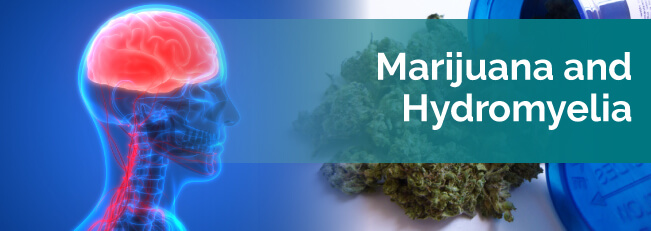
Hydromyelia is a condition affecting the spinal cord and primarily affects children with brain-related birth defects. The condition causes pain and stiffness that can range in severity from mild to severe. Traditional treatment methods come with potentially severe risks, so many patients seek alternative treatments to control the symptoms. Understanding the relationship between marijuana and hydromyelia can help you determine if it’s a suitable treatment option for your symptoms.
Hydromyelia is characterized by abnormal widening in the central canal of the spinal cord. The central canal is a small tube-like structure. It runs through the middle of the spinal cord. This widening forms a cavity, also called a syrinx, where spinal fluid accumulates. The most common location for this cavity is in the neck area.
When this cavity occurs, the spinal fluid often doesn’t flow normally, which causes expansion in the cavity. That build-up of spinal fluid creates pressure on the spinal cord that is higher than normal, possibly causing damage to nerve cells and connections.
That nerve damage can cause acute symptoms, and it can also cause permanent damage if not addressed. As the cavity grows, the potential damage to nerves and other symptoms caused by the condition tend to increase in severity.
Although the exact cause of hydromyelia is unknown, it is directly linked to any obstructions that block the flow of the cerebrospinal fluid within the brain and spinal cord. Depending on the origin of the condition, it can either be congenital, which means it is present from birth, or acquired syringomyelia, which can occur as a result of trauma, tumor, meningitis and arachnoiditis.
Hydromyelia and syringomyelia are often used interchangeably, but the two are separate conditions, though there are some similarities. Both cause cavities to form in the spinal cord. The cause of the cavity formation is the primary difference. Hydromyelia is most often associated with hydrocephalus in babies and children or with certain birth defects, including Chiari Malformation II and Dandy-Walker syndrome. These birth defects typically affect the brain. Syringomyelia mainly affects adults and stems from trauma to the spinal cord.
Hydromyelia affects people of all ethnicities and racial groups. The occurrence of the condition is difficult to determine, but estimates suggest the condition could affect anywhere from 1 in 18,000 people to 1 in 1,300 people in the United States.

As the pressure damages the nerve fibers, the patient may experience a wide variety of symptoms. Typically, affected individuals experience muscle stiffness, weakness and chronic pain. The weakness often affects the arms and hands, while the stiffness affects the legs, although those symptoms can be felt in various areas. Patients suffering from hydromyelia may lose their ability to distinguish between hot and cold objects.
They may also experience sensory loss in the neck and arms, while others face severe pain in those same areas. Headaches can also occur. Other symptoms may include bowel and bladder control issues, spasticity in the legs, visual disturbances, speech problems and scoliosis, or the curvature of the spine.
Though the symptoms vary from person to person, many symptoms grow in strength and frequency over time. Additionally, the progression of symptoms depends on the location of the spinal cavity and the speed in which it expands. Patients typically experience a slow, gradual increase in symptoms. However, letting the condition go untreated can cause permanent damage to the nerves.
The diagnosis process starts with a complete medical history, including the type of symptoms and how long the symptoms have been present. The physician may also ask about trauma to the spinal cord. A physical exam can check for symptoms of the condition, including weakness. Blood tests or other testing may be conducted to rule out other potential causes of the symptoms.
When other conditions are ruled out and hydromyelia is suspected, an MRI is often used to confirm the diagnosis of the condition. The MRI shows abnormalities in the spinal cord that indicate the presence of hydromyelia. The imaging test also helps the physician determine the severity of the syrinx and whether the spinal fluid is being obstructed.
Additional MRIs can help track the progression of the condition to determine if the patient needs additional treatment. Neurological tests can help diagnose the condition by checking for loss of sensation or changes in movements caused by hydromyelia.
The most common option for treating hydromyelia is through a surgical procedure to remove excess fluid and reduce compression in the area. This surgery allows the spinal fluid to flow normally again instead of building up and causing the increased pressure.
The surgery does come with the risk of potentially dangerous complications, however. The surgeon weighs the benefits and risks of the surgery to determine if a patient with hydromyelia is a good candidate for the procedure.
Surgery is often an option for children who have a neurological deficit due to the condition, particularly if those deficits are moderate or severe.
In some patients who have surgery for hydromyelia, the relief is permanent and no further treatment is needed. For other people, the surgery only provides temporary relief from the effects of hydromyelia. Those patients may need additional surgeries in the future to provide continued relief.
In some cases, the symptoms of hydromyelia are very minor, and the condition does not require any treatment. Those patients typically continue seeing specialists to monitor the condition to ensure it doesn’t increase in severity. It is possible that the condition will deteriorate and surgery will be necessary in the future. While very rare, hydromyelia can clear up on its own without any interventions.
Patients with hydromyelia may also take prescription pain relievers to eases the pain caused by the pressure on the nerves. These medications can have severe side effects, including addiction. Certain types of traditional pain relievers may cause permanent damage to the liver. Careful monitoring of the drug use is necessary to avoid these potentially serious side effects.

Therapy and rehabilitation services may also be part of the treatment process. Physical therapy, occupational therapy and speech therapy may be used to help patients deal with the symptoms and the effects of the condition.
Hydromyelia can be surgically treated by draining the cavities and implanting shunts if necessary. However, surgery on the spinal cord comes with the risk of potentially severe complications. The surgery isn’t always effective long term, which may require the patient to undergo more surgeries to relieve the symptoms of hydromyelia.
There is a far less invasive treatment for immediate pain relief. Pain is a primary symptom of the condition, and medical marijuana is known for its pain-relieving properties. Sativa-dominant strains are recommended for pain management, particularly muscle weakness and stiffness of arms, back, shoulders and legs. Medical marijuana ease the pain from the highly affected areas including the back, neck and shoulders.
Many patients prefer the safety of marijuana over the potential risk of surgery complications.
In addition to the pain relief, marijuana can help with sleep issues. Indica-dominant strains produce a sleepiness effect that can help you sleep. The combination of pain relief and sleepiness can help patients fall asleep and stay asleep better at night.
Research on cannabis and hydromyelia is limited due to weed’s status as a Schedule 1 drug. Federal regulations also make research more challenging. However, many studies and anecdotal evidence point to marijuana being effective for treating pain, inflammation and stiffness.
Marijuana is considered effective for a variety of pain types, including chronic pain, headaches, inflammation and neuropathic pain. To understand how marijuana helps with pain relief, it’s important to understand how the body’s endocannabinoid system works. Receptors in the endocannabinoid system are found throughout the body. Your body naturally produces chemicals called endocannabinoids.
These chemicals, and the system as a whole, keep the body in balance. The system affects almost all functions in the body, including the immune system, appetite, pain and other functions. The natural chemicals interact with the receptors to regulation those processes.
Marijuana contains a number of compounds called cannabinoids. These chemicals are similar to the natural chemicals created by the body. The cannabinoids in marijuana interact with the system’s receptors throughout the body. They can fill in for the natural endocannabinoids to help handle imbalances and symptoms to various conditions, including pain.
The cannabinoids in marijuana are also effective in treating inflammation, which is often a root cause of pain in the body. THC is one of the chemicals that fight inflammation. It is thought to have effective anti-inflammatory properties in addition to relieving pain.
CBD is another common cannabinoid that has an anti-inflammatory effect. Strains with both THC and CBD tend to have an entourage effect, which enhances the effectiveness of both components more than they would be on their own. Studies show that marijuana may help muscle stiffness and spasticity. Both these conditions may affect the body due to hydromyelia.
When treating the symptoms of hydromyelia, choosing the best strain of marijuana is important. It may take you some time to find a strain that works well for you, as each person responds differently to the various strains. If you don’t find the relief you want from your first experience with medical marijuana, consider trying a different strain.
Like doctors adjust prescription medications, it can take experimentation and time to find the right strain and ingestion method of marijuana to for an effective combination.
The first decision is between Sativa and Indica strains. Both provide pain-relieving qualities. Sativa creates an uplifting, energizing feeling in most people, while Indica tends to have a relaxing, drowsy effect. Keep those effects in mind when choosing a strain. If you’re treating a child who needs to stay awake during the day, a Sativa strain may be more appropriate. The same is true for an adult who needs to remain alert for work or other activities.

If you have difficulty sleeping due to the pain and other symptoms of hydromyelia, an Indica strain may be a more appropriate option, at least for nighttime. The drowsiness may help you get better sleep, especially when paired with the pain relief offered by marijuana.
Some strains that may work well for hydromyelia include:
You have several options for ingesting the selected strain of marijuana. The method you choose depends on personal preference and the age of the patient. For example, kids and people with breathing issues won’t want to smoke marijuana. Consult with your qualified medical marijuana doctor to determine the best strain and method of ingestion.
The common ingestion options for cannabis for hydromyelia include:
The dosages of marijuana are typically very controlled with this option. Edibles take longer than other methods to take effect — you may have to wait up to a few hours for it to work. These products can also be potentially dangerous with kids or pets in the home. They may be mistaken for regular snacks.
Topical lotions and similar products can be applied directly to areas affected by pain, which makes them ideal for addressing specific pain points caused by the condition. For example, you can apply the product to your neck if you experience pain in this area.

Patients often find a combination of ingestion methods provides the best balance, particularly for adult patients who have more flexibility in methods. In some cases, the quick relief of smoking or vaping is preferable. In other cases, the patient prefers the longer-lasting edible method.
When compared with the potential risks of surgery and the potential side effects of traditional pain relievers, marijuana is a safe, natural alternative with little risk. While the marijuana does have some effects on the body, they are generally mild and go away when you stop using cannabis.
Some of the effects of marijuana include:
Hydromyelia can cause significant pain and symptoms that affect your daily activities. While surgery and traditional pain relievers are an option, they come with potentially serious risks. Marijuana is an affordable, natural option for treating those symptoms.
If you or a loved one has hydromyelia and you want to know more about using marijuana to treat the symptoms, we can help. We’ll connect you with qualified marijuana doctors in all legal marijuana states to ensure you remain compliant with all local laws. Find a doctor now, and find out how you can start improving your quality of life with less pain from hydromyelia.
For more information about how cannabis can be used to treat Hydromyelia, check out our resources:
Find A Doctor Find A Dispensary